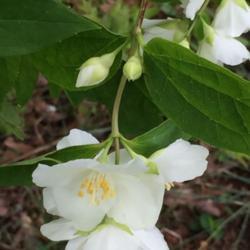According to Idaho Mountain Wildflowers, by A. Scott Earle and Jane Lundin, Lewis' mock orange was collected by Meriwether Lewis along the Clearwater River on May 6, 1806, and again on July 4, 1806, on the Bitterroot River.

The Sweet Mockorange is native to southeast Europe and Asia Minor. It is an old-fashioned shrub that was used a good amount in the Midwest, Mid-Atlantic, and Northeast USA in many landscapes from the late 1800's into the 1960's, and many are still alive. It grows to be a large, rounded shrub with stiff ascending branches that arch with age, and it is rather twiggy and gets straggly. It is noted as having very sweetly fragrant flowers in late May into early June for about 10 days or so. It does not develop fall colour. It is very reliable; not bothered by anything serious. Very few conventional nurseries offer this species now. The trend has been to have smaller Mockoranges that bear double flowers.

The blooms appear on previous year's growth, so prune right after flowering. It can also be cut to the ground after flowering if shrub becomes scraggly looking or otherwise in need of rejuvenation. I just pruned mine in half and the new growth is now fuller and lusher than last year.

The old-fashioned Sweet Mockorange was a fairly common plant back in the late 19th century and early to mid-20th century and it lost favor in more modern landscapes and gardens being so big and not being full of ornamental characteristics. Nurseries turned to growing smaller Mockoranges as this cultivar that grows about 6 to 8 feet high and 5 to 6 feet wide. Some shorter 3 to 5 feet high cultivars were also developed. I don't see any mockoranges as being common in the Midwest or Mid-Atlantic nowadays, but one can occasionally find some. Mockoranges are not really the highest quality or really attractive plants. They eventually get messy in twigginess and don't develop fall color. The fragrant white flowers are their best feature and not much more. This Minnesota Snowflake seems to be the most common cultivar offered since the 1980's. It bears fragrant double white flowers.

This dwarf cultivar is sold by a few conventional and mail order nurseries, such as Midwest groundcovers in St Charles, IL. It began as a sport branch from 'Minnesota Snowflake' from the large Bailey Nursery in southern Minnesota. It produces a lot of white double fragrant flowers and has dark green foliage. I occasionally see it grown by homeowners who are enthusiastic about gardening.

Scentless Mock Orange is a multi-stemmed shrub that can reach 10' in height. It has upright arching branches with pretty, although non-fragrant blooms that usually appear in the month of May. This plant received its common name of "Mock Orange" because the blooms resemble those of citrus trees (orange blossoms).
